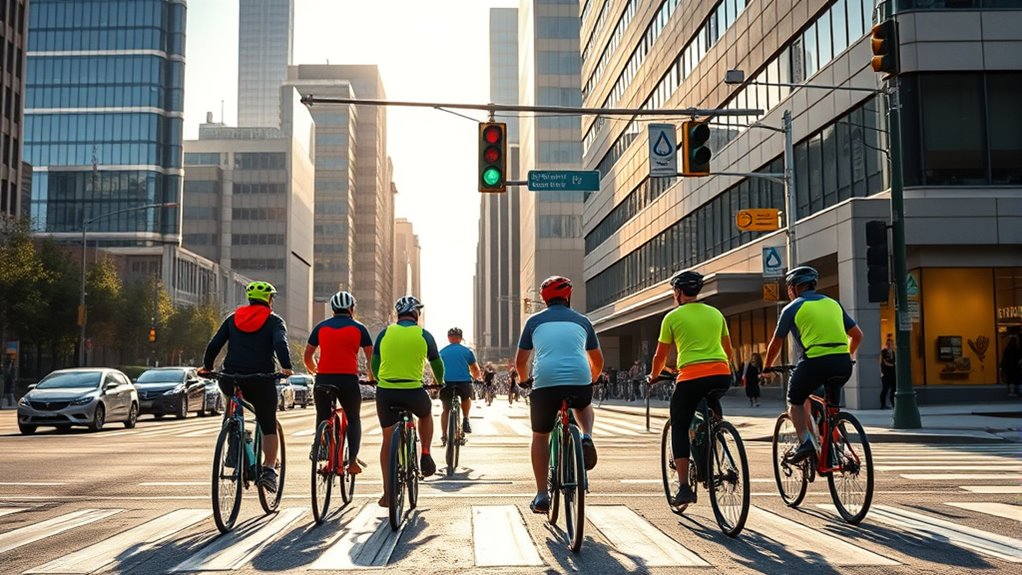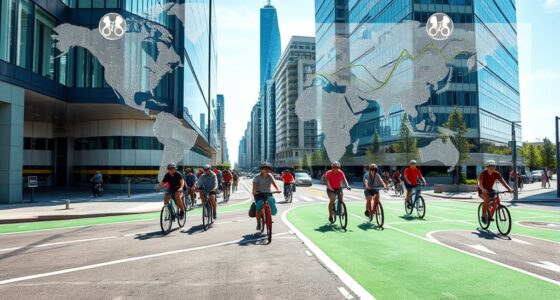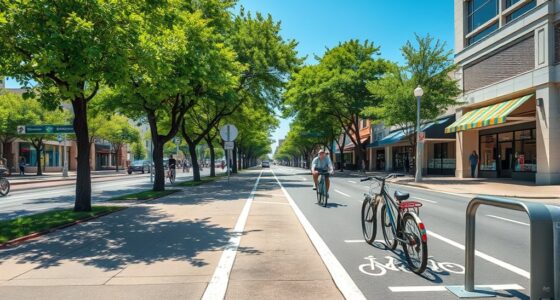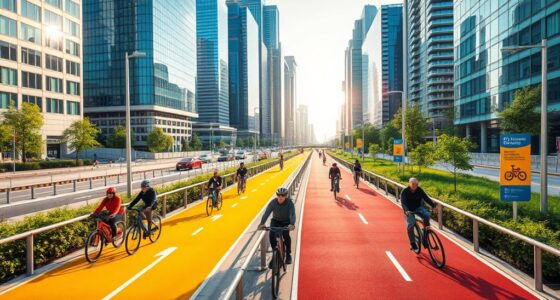Implementing infrastructure improvements is essential for achieving Vision Zero goals and keeping cyclists safe. You’ll see protected bike lanes, clearer signage, better lighting, and safer intersection designs that reduce conflicts with motor vehicles. These upgrades foster a safer, more predictable environment where cyclists can ride with confidence. If you want to learn how cities are creating safer streets and reducing accidents for cyclists, explore further to discover impactful strategies and success stories.
Key Takeaways
- Infrastructure improvements like dedicated bike lanes and protected intersections reduce cyclist-motor vehicle conflicts.
- Safer street designs enhance cyclist predictability and visibility, lowering accident risks.
- City investments and community input prioritize cyclist safety and support ongoing infrastructure upgrades.
- Improved lighting, signage, and traffic calming measures create a safer environment for cyclists.
- Strategic infrastructure development advances Vision Zero goals by reducing cyclist injuries and fatalities.
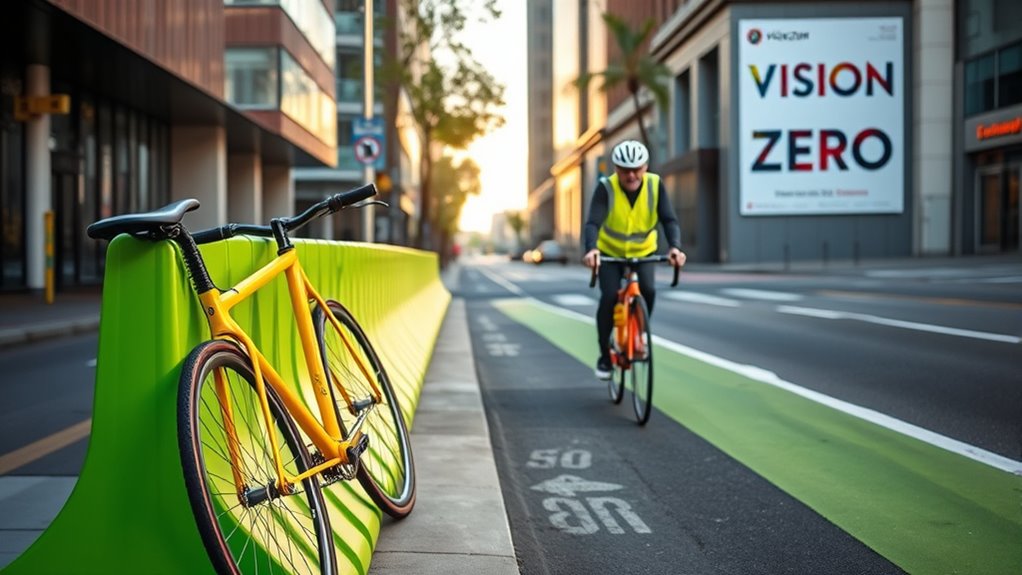
Vision Zero aims to eliminate traffic fatalities, and cyclists are a critical part of this goal. As a cyclist, your safety depends heavily on the measures cities implement to protect you on the road. One of the most effective ways to enhance cyclist safety is through targeted infrastructure improvements. These improvements aren’t just about adding bike lanes; they involve designing streets that reduce conflicts between cyclists and motor vehicles, making your ride safer and more predictable. When cities invest in dedicated bike lanes, protected intersections, and clear signage, they create a safer environment where cyclists can navigate with confidence. Infrastructure improvements also mean better lighting, traffic calming measures, and redesigned intersections that minimize dangerous turning conflicts, all of which directly protect you from accidents.
Targeted infrastructure improvements like protected bike lanes and clear signage enhance cyclist safety and confidence on city streets.
As a cyclist, you benefit from infrastructure improvements that help you feel secure and reduce the risk of collisions. Protected bike lanes, for example, create a physical barrier separating you from fast-moving traffic, giving you a safe space to ride. These lanes are often placed away from parking areas and vehicle lanes, reducing the chances of dooring incidents and side-swipes. Intersections are typically the most dangerous spots for cyclists, so improvements like advanced stop lines, dedicated signal phases, and curb extensions help make crossing safer. These features lower the likelihood of turning vehicles hitting you and improve visibility for all road users. Proper infrastructure also includes wayfinding signs and markings that guide you along safe routes, making it easier to plan your trips and avoid complex or hazardous areas. Utilizing scenic views and natural beauty in your cycling routes can also enhance your experience, encouraging safer and more enjoyable rides.
Your role in promoting cyclist safety is also influenced by how well cities prioritize infrastructure improvements as part of their Vision Zero strategies. When local governments commit resources to upgrading streets, it sends a clear message that your safety matters. These investments often come with ongoing maintenance, ensuring that bike lanes remain clear of debris, potholes, and obstructions that could cause accidents. furthermore, community engagement in planning these improvements allows you to voice concerns and suggest changes that directly impact your safety. As infrastructure evolves, so does your ability to ride confidently, knowing that efforts are underway to protect you and reduce the likelihood of traffic-related injuries or fatalities.
Ultimately, infrastructure improvements are a cornerstone of Vision Zero’s success in making streets safer for cyclists. They transform streets into environments where you can ride with less fear and greater security. When cities prioritize cyclist safety through thoughtful design and continuous upgrades, they create a culture of safety that benefits everyone—drivers, pedestrians, and cyclists alike. Your safety on the road depends on these smart, strategic changes, and your support for such initiatives helps push forward the vision of zero traffic deaths.
Frequently Asked Questions
How Does Vision Zero Prioritize Cyclist Safety Specifically?
You see that Vision Zero prioritizes cyclist safety by implementing policy collaboration with local governments and organizations to create safer infrastructure. Educational campaigns target both drivers and cyclists, raising awareness and promoting safe behaviors. These initiatives encourage shared responsibility on the road, reduce accidents, and foster a safer environment for cyclists. By combining policy efforts and education, Vision Zero actively works to protect cyclists and make streets safer for everyone.
What Infrastructure Changes Are Planned to Protect Cyclists?
You’ll notice plans for bike lane expansion and intersection redesigns aimed at creating safer routes. These infrastructure upgrades include wider, protected bike lanes that keep cyclists separated from traffic and smarter intersection layouts that reduce conflict points. By implementing these changes, the city is actively working to make cycling safer and more inviting, encouraging more people to choose bikes over cars and making your commute smoother and more secure.
Are There Penalties for Drivers Who Harm Cyclists?
Yes, there are legal consequences for drivers who harm cyclists. Enforcement strategies include strict penalties such as fines, license suspensions, or even criminal charges depending on the severity of the incident. Authorities actively monitor traffic violations and pursue legal action to hold reckless drivers accountable. By implementing these measures, you help promote safer roads and ensure that drivers understand the importance of respecting cyclists’ rights and safety.
How Does Vision Zero Address Cyclist Visibility Issues?
You might think visibility isn’t a big deal, but Vision Zero tackles it head-on by promoting bike lane enforcement and cyclist education. It guarantees drivers see cyclists clearly and understand their rights, reducing accidents. By focusing on better signage, lighting, and public awareness campaigns, it creates a safer environment. So, if you’re cycling, know that these measures help you stay visible and protected on the road, making your ride safer.
What Community Programs Support Cyclist Safety Initiatives?
You can get involved in community programs that support cyclist safety initiatives by participating in urban planning efforts and public awareness campaigns. These programs often organize bike safety classes, advocate for protected bike lanes, and promote educational events to raise awareness about cyclist rights and safety. By engaging with local groups or city-sponsored initiatives, you help foster a safer environment for cyclists and encourage responsible sharing of road space.
Conclusion
As you ride through the city, remember that Vision Zero is the guiding light illuminating the path to safety for every cyclist. It’s a beacon that transforms busy streets into a shared sanctuary, where helmets symbolize protection and hope. By embracing this vision, you become an essential part of the chain that breaks barriers and creates safer roads. Together, we can turn these symbols into reality—where every pedal stroke leads to a safer, brighter horizon for all cyclists.
